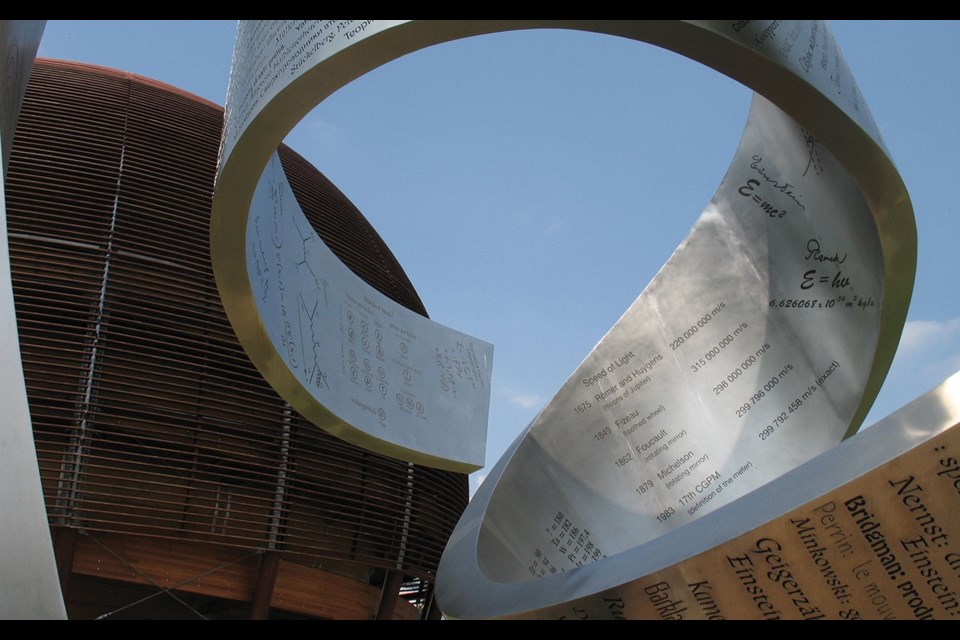July 4, 2012: Sensational headlines were everywhere—and they had nothing to do with America's Independence Day. CERN was at the heart of them.
The Higgs boson, an elementary particle crucial for verifying the Standard Model of particle physics, had finally been discovered at the huge 27-kilometre-circumference Large Hadron Collider (LHC), the most powerful particle accelerator in the world.
While it's home to many research sites, the LHC is the flagship of CERN—the French acronym for the European Organization for Nuclear Research, the world's largest particle physics research facility.
Founded after the Second World War to boost European science, the centre now resembles a post-modernist mini-city that sits 30 minutes by tram northwest of Geneva. (You won't miss your stop—the huge round, wooden Globe of Science and Innovation makes an outstanding landmark and, along with the Microcosm exhibition, is the best place to start your visit before signing in across the street.)
The Higgs boson had not been found since its existence was predicted in the 1960s by six theorists, including its namesake, Peter Higgs. On that monumental July day, the distinguished Dr. Higgs, then 83, and fellow physicist, Dr. François Englert, were obviously moved as they sat in the packed CERN auditorium, tears spilling down their cheeks while the discovery's details were unveiled. The following year, Higgs and Englert received the Nobel Prize in Physics.
Today, it's still very moving to sit in that auditorium, and you can, too, when you take one of CERN's free public tours. Our group included 20-some young, energetic British students, and a hush fell over us all as we entered.
Last year, more than 135,000 people visited CERN, which sits astride the Franco-Swiss border near Geneva. Scads of people I know have always wanted to go, but haven't, even after the Higgs discovery. If you're one of them, now there's an even better incentive besides sitting in that hallowed auditorium.
With the LHC shut down until 2021 for a major upgrade (only the second time in its 11-year history), you can experience some of CERN's coolest sites in exceptional ways as they "open up" the equipment for upgrades—massive equipment festooned with complicated nests of colourful wires or golden blades that look like giant windmills. The scale is mind-blowing. The ATLAS detector itself, which we saw, weighs 7,000 tonnes!
It feels like you're inside a sci-fi world as yet undiscovered, and it's all used to chase the biggest questions we humans have: What is the universe made of? Where did we come from?
But don't worry, you won't be intimidated. Smart, easy-going tour guides, like Canadian physicist Kate Whalen from New Brunswick, are excellent at explaining what you see.
When we visited CERN this July, it was during another big European heat wave. Temperatures hit a record 45 C in France. Near beautiful Lake Geneva, with the Valais Alps in the distance, it was "only" 38 C. So it was refreshing stepping into CERN's air-conditioned lobby to register and get our security passes.
On the front doors, I was excited just seeing the distinctive CERN logo, which represents particle accelerators. On the floor, you can't miss an amazing mosaic. Serge Moro's "Cosmic Song," built at CERN workshops, uses fluorescent light effects governed by the constant rain of cosmic ray particles from outer space.
In fact, you'll soon see that the entire CERN site is filled with all kinds of art and moving stories, from busts of physicists like Marie Curie to huge, colourful murals. My favourite was the swirling, 11-metre, stainless-steel ribbon sculpture near the Globe. Created by Canadian artist Gayle Hermick, it features formulae and inscriptions from nearly 400 scientific discoveries in the language of their origin, starting with cuneiform from ancient Mesopotamia.
But the best was yet to come...
We were unusually lucky on one of our visits and had a rare tour of the LHC tunnel located 25 storeys underground so it's not impacted by radiation (plus it was cheaper than acquiring land on the surface!). After donning hard hats and going down, down, down the concrete elevator shaft, the tunnel was serene and cool—almost like a sanctuary.
The LHC itself is, essentially, two large tubes called beam pipes where sub-atomic particles are accelerated close to the speed of light using giant electromagnets, then smashed together. The reactions are tracked on huge detectors located at various experimental sites around the LHC. The strange thing was when I saw the joints in the exposed beam pipes, I couldn't help but think of our old vacuum cleaner hose at home!
You never know which sites you'll visit at CERN since you're clustered in groups according to language, but there's so much you'll want to see, you'll just have to come back for more. You must sign up for tours, so here's my best tip: Go to Visit CERN well before you leave, and take as many as time allows.
To read Glenda's feature on CERN in the Pique go to piquenewsmagazine.com, Dec. 5.




